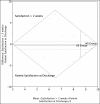Comparison of ultrasound and nerve stimulation techniques for interscalene brachial plexus block for shoulder surgery in a residency training environment: a randomized, controlled, observer-blinded trial
- PMID: 21960758
- PMCID: PMC3179192
Comparison of ultrasound and nerve stimulation techniques for interscalene brachial plexus block for shoulder surgery in a residency training environment: a randomized, controlled, observer-blinded trial
Erratum in
- Ochsner J. 2012 Spring;12(1):86
Abstract
Background: The ability to provide adequate intraoperative anesthesia and postoperative analgesia for orthopedic shoulder surgery continues to be a procedural challenge. Anesthesiology training programs constantly balance the time needed for procedural education versus associated costs. The administration of brachial plexus anesthesia can be facilitated through nerve stimulation or by ultrasound guidance. The benefits of using a nerve stimulator include a high incidence of success and less cost when compared to ultrasonography. Recent studies with ultrasonography suggest high success rates and decreased procedural times, but less is known about the comparison of these procedural times in training programs. We conducted a prospective, randomized, observer-blinded study with inexperienced clinical anesthesia (CA) residents-CA-1 to CA-3-to compare differences in these 2 guidance techniques in patients undergoing interscalene brachial plexus block for orthopedic surgery.
Methods: In this study, 41 patients scheduled for orthopedic shoulder surgery were randomly assigned to receive an interscalene brachial plexus block guided by either ultrasound (US group) or nerve stimulation (NS group). Preoperative analgesics and sedatives were controlled in both groups.
Results: The US group required significantly less time to conduct the block (4.3 ± 1.5 minutes) than the NS group (10 ± 1.5 minutes), P = .009. Moreover, the US group achieved a significantly faster onset of sensory block (US group, 12 ± 2 minutes; NS group, 19 ± 2 minutes; P = .02) and motor block (US group, 13.5 ± 2.3 minutes; NS group, 20.2 ± 2.1 minutes; P = .03). Success rates were high for both techniques and were not statistically different (US group, 95%; NS group, 91%). No differences were found in operative times, postoperative pain scores, need for rescue analgesics, or incidences of perioperative or postdischarge side effects.
Conclusion: On the basis of our results with inexperienced residents, we found that using US in guiding the interscalene approach to the brachial plexus significantly shortened the duration of intervals in conduction of the block and onset of anesthesia when compared with NS; moreover, these times could have significant cost savings for the institution. Finally, the use of US technology in an academic medical center facilitates safe, cost-effective, quality care.
Keywords: Interscalene brachial plexus block; mepivacaine; nerve stimulator equipment; regional anesthetic technique; ropivacaine; ultrasound equipment.
Figures



References
-
- Winnie AP. Interscalene brachial plexus block. Anesth Analg. 1970;49(3):455–466. - PubMed
-
- Conn RA, Cofield RH, Byer DE, Linstromberg JW. Interscalene block anesthesia for shoulder surgery. Clin Orthop Relat Res. 1987;216:94–98. - PubMed
-
- Tetzlaff JE, Yoon HJ, Brems J. Interscalene brachial plexus block for shoulder surgery. Reg Anesth. 1994;19(5):339–343. - PubMed
-
- Urban MK, Urquhart B. Evaluation of brachial plexus anesthesia for upper extremity surgery. Reg Anesth. 1994;19(3):175–182. - PubMed
-
- Bishop JY, Sprague M, Gelber J, et al. Interscalene regional anesthesia for arthroscopic shoulder surgery: a safe and effective technique. J Shoulder Elbow Surg. 2006;15(5):567–570. - PubMed
LinkOut - more resources
Full Text Sources
Other Literature Sources
Miscellaneous
